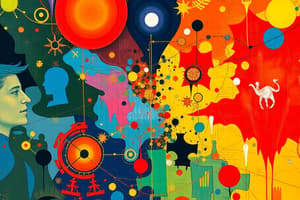Podcast
Questions and Answers
What is the primary purpose of making assumptions in economic models?
What is the primary purpose of making assumptions in economic models?
- To enhance the complexity of economic analysis
- To analyze cause and effect effectively (correct)
- To eliminate all uncertainties in economics
- To create a detailed representation of reality
Which of the following best describes the circular-flow diagram?
Which of the following best describes the circular-flow diagram?
- It highlights the impact of inflation on production.
- It illustrates the production possibilities of a single firm.
- It shows the trade-offs between domestic and international markets.
- It represents the relationship between households and firms in the economy. (correct)
Which economic model shows the trade-offs between producing two different goods?
Which economic model shows the trade-offs between producing two different goods?
- Supply and Demand Curve
- Circular-Flow Diagram
- Market Equilibrium Diagram
- Production Possibilities Frontier (PPF) (correct)
What does a point inside the production possibilities frontier (PPF) indicate?
What does a point inside the production possibilities frontier (PPF) indicate?
Microeconomics primarily focuses on which of the following?
Microeconomics primarily focuses on which of the following?
Which of the following is NOT a key element illustrated by the Production Possibilities Frontier?
Which of the following is NOT a key element illustrated by the Production Possibilities Frontier?
In the markets for factors of production, what is the role of households?
In the markets for factors of production, what is the role of households?
What is a significant aspect of using economic models?
What is a significant aspect of using economic models?
Which of the following topics does not fall within the study of microeconomics?
Which of the following topics does not fall within the study of microeconomics?
Which statement best exemplifies a positive analysis?
Which statement best exemplifies a positive analysis?
Why might economists disagree on certain policy recommendations?
Why might economists disagree on certain policy recommendations?
What is a common belief among economists regarding tariffs?
What is a common belief among economists regarding tariffs?
Which part of the government regularly relies on the advice of economists?
Which part of the government regularly relies on the advice of economists?
What characterizes normative statements as opposed to positive statements?
What characterizes normative statements as opposed to positive statements?
Which of the following issues would an economist likely analyze positively?
Which of the following issues would an economist likely analyze positively?
What can lead to economists having different opinions on the effectiveness of policies?
What can lead to economists having different opinions on the effectiveness of policies?
Flashcards are hidden until you start studying
Study Notes
The Scientific Method in Economics
- Economists study real-world phenomena, create theories, and analyze data.
- Assumptions simplify complex situations to understand cause and effect.
- Testing hypotheses is essential for economic analysis.
The Role of Assumptions
- Assumptions simplify the world to make it easier to understand.
- Example: In international trade models, economists assume only two countries to focus on trade patterns.
Economic Models
- Simplified representations of reality used to analyze economic situations.
- Key models include the Circular-Flow Diagram and the Production Possibilities Frontier (PPF).
Circular-Flow Diagram
- Shows the flow of goods and services between households and firms in the economy.
- Two main markets:
- Market for goods and services
- Market for factors of production
Production Possibilities Frontier (PPF)
- Shows the trade-offs between producing two goods.
- Illustrates opportunity costs, efficiency, and economic growth.
Microeconomics vs. Macroeconomics
- Microeconomics studies individual markets and decision-makers (households and firms).
- Macroeconomics focuses on broader economic factors like inflation, unemployment, and national income.
Positive vs. Normative Analysis
- Positive Statements: Objective and fact-based.
- Normative Statements: Subjective and value-based.
- Example:
- Positive: ”Increasing the minimum wage will reduce employment.”
- Normative: ”The government should raise the minimum wage.”
- Example:
Economists as Policy Advisers
- Economists provide advice to policymakers based on positive analysis.
- Example: Advising on minimum wage laws, taxation, and healthcare reforms.
Why Economists Disagree
- Differences in scientific judgments and models.
- Differences in values (e.g., fairness vs. efficiency).
Studying That Suits You
Use AI to generate personalized quizzes and flashcards to suit your learning preferences.




